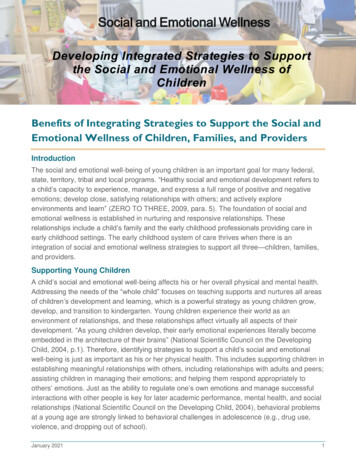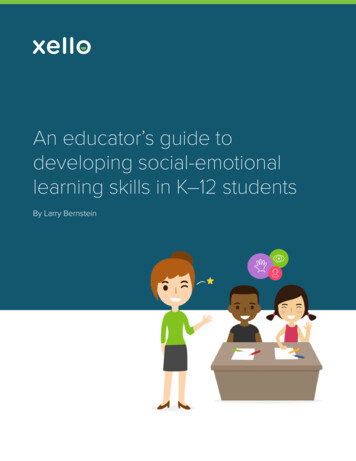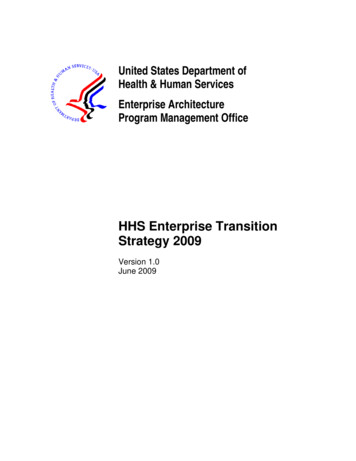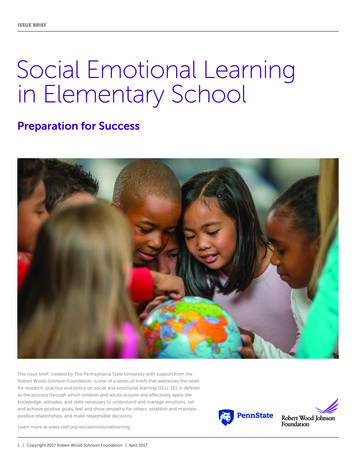
Transcription
Social and Emotional WellnessDeveloping Integrated Strategies to Supportthe Social and Emotional Wellness ofChildrenBenefits of Integrating Strategies to Support the Social andEmotional Wellness of Children, Families, and ProvidersIntroductionThe social and emotional well-being of young children is an important goal for many federal,state, territory, tribal and local programs. “Healthy social and emotional development refers toa child’s capacity to experience, manage, and express a full range of positive and negativeemotions; develop close, satisfying relationships with others; and actively exploreenvironments and learn” (ZERO TO THREE, 2009, para. 5). The foundation of social andemotional wellness is established in nurturing and responsive relationships. Theserelationships include a child’s family and the early childhood professionals providing care inearly childhood settings. The early childhood system of care thrives when there is anintegration of social and emotional wellness strategies to support all three—children, families,and providers.Supporting Young ChildrenA child’s social and emotional well-being affects his or her overall physical and mental health.Addressing the needs of the “whole child” focuses on teaching supports and nurtures all areasof children’s development and learning, which is a powerful strategy as young children grow,develop, and transition to kindergarten. Young children experience their world as anenvironment of relationships, and these relationships affect virtually all aspects of theirdevelopment. “As young children develop, their early emotional experiences literally becomeembedded in the architecture of their brains” (National Scientific Council on the DevelopingChild, 2004, p.1). Therefore, identifying strategies to support a child’s social and emotionalwell-being is just as important as his or her physical health. This includes supporting children inestablishing meaningful relationships with others, including relationships with adults and peers;assisting children in managing their emotions; and helping them respond appropriately toothers’ emotions. Just as the ability to regulate one’s own emotions and manage successfulinteractions with other people is key for later academic performance, mental health, and socialrelationships (National Scientific Council on the Developing Child, 2004), behavioral problemsat a young age are strongly linked to behavioral challenges in adolescence (e.g., drug use,violence, and dropping out of school).January 20211
SOCIAL AND EMOTIONAL WELLNESSDeveloping Integrated Strategies to Support the Social and Emotional Wellness of ChildrenStrategies that might be integrated into a state, territory, or tribal system to support youngchildren include the following:1. Implementation of a social and emotional learningprogram, such as Circle of Security or IncredibleYears2. Adoption of positive behavior interventions andsupport frameworks, such as the Pyramid Model forPromoting the Social and Emotional Competence inInfants and Young Children3. Embedding of social and emotional indicators for quality rating improvement systems4. Inclusion of social and emotional development in early learning guidelinesSupporting FamiliesEffective strategies to support the social and emotionalwellness of children include engaging children’s families.The stability and quality of a child’s relationship withcaring adults lay the foundation for his or herdevelopmental outcomes. Social and emotional wellnessstrategies that include families allow adults to learn how tosupport their child in building social and emotional skillsand teach adults themselves how to practice and model such skills (McClelland et al., 2017). Inaddition, early emotional and social development must be incorporated into services to supportparents who are struggling to manage routine behavioral difficulties in their young children, aswell as those who are trying to figure out whether, when, and how to deal with more serioussocial or emotional problems (Brooks-Gunn et al., 2000).Strategies that might be integrated into a state, territory, or tribal system to support familiesinclude the following:1. Inclusion of a social and emotional protective factors framework, such as StrengtheningFamilies2. Adoption of a statewide initiative to support a statewide network of resources for parentsand families, such as Help Me GrowSupporting Early Childhood ProfessionalsFinally, providing supports for early childhood professionals in early learning settings affectsthe degree to which a child’s social and emotional wellness is fostered. The science ofdevelopment supports that “greater attention must be focused on the social and emotionaldevelopment of children in both pre-professional training programs and continuing professionalJanuary 20212
SOCIAL AND EMOTIONAL WELLNESSDeveloping Integrated Strategies to Support the Social and Emotional Wellness of Childreneducation” (National Scientific Council on the Developing Child, 2004, p. 4). Providing trainingon social and emotional wellness reduces the incidence of expulsion of young children fromearly childhood programs and increases the confidence of early childhood professionals tosupport children with challenging behaviors. Strategies such as the Pyramid Approach andinfant and early childhood mental health consultation reinforce the facilitation of a sharedapproach with caregivers to support social and emotional well-being in early childhood.Strategies that might be integrated into a state, territory, or tribal system to support earlylearning and school-age programs include the following:1. Integration of responsive caregiving or relationshipbased care training and professional development2. Incorporation of social and emotional professionaldevelopment, intentionally supporting skills childrenneed to manage their emotions and recognize theemotions of others (e.g., emotional literacy, emotionalregulation, empathy, and perspective-taking), whichwould also include social skills, such as socialunderstanding, development of self-confidence, and positive social interactions with peersand adults3. Increased access to infant and early childhood mental health consultants to support earlychildhood professionals4. Increased access to coaches who can support responsive, relationship-based care5. Professional development on the use of social and emotional learning screeners6. Use of child care health consultants to support developmental surveillance or screening inearly childhood settings7. Support of trauma-responsive training for early childhood professionals8. Creation and adoption of a social and emotional toolkit for use by providers9. Identification and alignment of social and emotional measurement strategies acrossinitiatives and organizations using the Common Indicators of Social-Emotional Well-Beingin Early Childhood, which is being piloted by Project Linking Actions for Unmet Needs inChildren’s Health and Child Trends10. Ensure core knowledge and competencies for the early childhood workforce include afocus on the understanding of best practices to support social and emotional developmentJanuary 20213
SOCIAL AND EMOTIONAL WELLNESSDeveloping Integrated Strategies to Support the Social and Emotional Wellness of Children11. Implementation of social and emotional professionaldevelopment to support social and emotional learning skills inschool-age children (including emotional literacy, emotionalregulation, insight building, empathy, perspective-taking, andproblem-solving) and the embedding of supporting skills,such as communication skills, social understanding,development of self-confidence, assertiveness, and positivesocial interactions with peers and adults12. Support of trauma-responsive training for youth careprofessionals (see the National Center on Afterschool and Summer Enrichment’s AdverseChildhood Experiences Resources)13. Creation and adoption of a social and emotional learning toolkit for use by providers, likethe Afterschool Alliance’s Social Emotional Learning toolkitBenefits of Implementing an Integrated andComprehensive System of Social and Emotional SupportsResearch indicates that children that have a strong social and emotional foundation haveincreased benefits in the following areas: Better physical health—improving social and emotional skills promotes healthier lifestyles, reducesrisky behavior such as substance use, and has been linked with a lower body mass index (Bavarianet al., 2006; Moffitt et al., 2011) Improved academic achievement and increased school readiness Increased ability to follow classroom rules and routines Enhanced attention span and ability to persist at challenging tasks,which predicts greater enjoyment of school Reduced problem behaviors Elevated rates of high school graduation and productiveemployment (Jones et al., 2015)Benefits for families include the following: Enhanced confidence in their parenting skills Increased understanding of social and emotional wellness Improved ability to manage children’s difficult behaviorsJanuary 20214
SOCIAL AND EMOTIONAL WELLNESSDeveloping Integrated Strategies to Support the Social and Emotional Wellness of ChildrenBenefits for early learning programs include the following: Increased family engagement Increased staff “competence and confidence in the support of children” “Reduced turnover in the program” “Reductions in child challenging behavior” “Increases in children’s social skills” “Increased satisfaction of program staff and families” “Changes in classroom and program climate”(National Center for Pyramid Model Innovations, n.d., para. 3)Implementation Considerations—Theory of Change andLogic ModelsPromising practices show that an effective implementation strategy for launching a newinitiative contains four essential elements: an articulated theory of change model (addressingwhat you are trying to achieve) to guide services, initiative delivery strategies, staff-providerrelationships, and staff training and support. Before embarking on the implementation of asocial and emotional wellness initiative, stakeholders should clearly define and articulate thescope and focus of the work. A theory of change and a logic model are two tools that supportthe development of a comprehensive plan to articulate the “what,” “why,” and “how” of a socialand emotional wellness initiative.What Is a Theory of Change?A theory of change is an essential driver in effectively designing, operating, and evaluating anynew initiative. It describes “the set of assumptions that explain both the mini-steps that lead tothe long term goal of interest and the connections between program activities and outcomesthat occur at each step of the way” (Weiss, 1995). A well-articulated theory of change allowsChild Care and Development Fund (CCDF) Administrators to identify goals and variables thatneed to be measured in order to support anticipated outcomes. “From a practical point of view,going through the exercise of developing, refining, and promoting a theory of change enablesprogram leadership and staff to articulate the “what,” “why,” and “how”” of interventions thatimprove social and emotional wellness (Center of Excellence for Infant and Early ChildhoodMental Health Consultation, n.d., para. 1).What Does a Theory of Change Model Look Like?“A basic TOC [theory of change model] explains how a group of early and intermediateaccomplishments sets the stage for producing long-range results. A more complete TOCJanuary 20215
SOCIAL AND EMOTIONAL WELLNESSDeveloping Integrated Strategies to Support the Social and Emotional Wellness of Childrenarticulates the assumptions about the process through which change will occur and specifiesthe ways in which all of the required early and intermediate outcomes related to achieving thedesired long-term change will be brought about and documented as they occur” (de la Mata,2018, paras. 7–8).A theory of change tool can be found in the Innovation for Social Change’s A Tool to DevelopYour Theory of Change. The Center of Excellence for Infant and Early Childhood MentalHealth Consultation describes an example of a theory of change developed by Dr. DeborahPerry in Theory of Change Examples from GUCCHD and Arizona's Smart Support Program.What Is a Logic Model?“A logic model is a graphic depiction (road map) that presents the shared relationships amongthe resources, activities, outputs, outcomes, and impact for your program. It depicts therelationship between your program’s activities and its intended effects” (Centers for DiseaseControl and Prevention, n.d., para. 1). Logic models are particularly important to use inestablishing your goals, which are uniquely linked to your intended target population.Like a road map, a logic model shows the intended route and the steps to be taken to reach aspecific endpoint. A detailed model indicates how each activity will lead to desired changes. Alogic model also expresses the thinking behind your initiative plan and helps makestakeholders’ expectations explicit. Appendix A covers guidance on developing a logic modeland a logic model template.How Do These Differ?A theory of change differs from a logic model in that the primary purpose of a theory of changeis to explain the cause and effect between specific elements of an intervention and a particularoutcome. While a logic model graphically displays the link between inputs, outputs, andoutcomes, it does not explain the necessary conditions under which that outcome is expectedto result. Logic models also provide important contextual information, such as whostakeholders for the program are, the rationale for selecting this program for this population,and other elements. The theory of change gives the “big picture” and summarizes work at astrategic level, while a logic model illustrates the implementation-level understanding of thechange process.Developing a Logic ModelIdeally, a logic model is developed during your design of the initiative. However, networkpartners can create a logic model at any time to help bring clarity to the work, createconsensus or a better understanding of the network, or help focus an evaluation. A clearlyarticulated logic model will help identify the scope and goals of your initiative. A logic model willhelp stakeholders do the following:January 20216
SOCIAL AND EMOTIONAL WELLNESSDeveloping Integrated Strategies to Support the Social and Emotional Wellness of Children Articulate their understanding of the current community or state needs related to social andemotional wellness and determine the changes they hope to make through a targeted initiativeimplementation. Identify who needs to be involved in the initiative planningand implementation and whom the initiative is targeting. Identify activities planned to contribute toward the initiative. Determine the resources needed to launch and sustain theinitiative. Clarify assumptions and examine the external factors thatcould influence the results.Initiative Delivery StrategiesIdeally, decisions about service delivery strategies are grounded in evidence that suggests thatthe strategy will help produce positive results and is informed by valid and reliable data. Inaddition, launching a child, family, and provider social and emotional wellness strategy shouldconsider the reality of using specific strategies (for example, professional development,coaching, or consultation services) based on the following: The identified interests, strengths, and needs of children, families, and providers The community and early care and education system context, including other resources andservices available Ways to avoid duplication and maximize partnering withexisting resources across all sectors (e.g., health, earlylearning, family support, home visiting, and communityinstitutions) An analysis of the equity of services available and barriers toaccessing them, such as opportunities for training andprofessional development or availability of training in a firstlanguage Opportunities for training and coordination across resourcesfor other early learning programs (e.g., schools, centers, homevisiting, and family child care) Available personnel and funding The time it takes to achieve the intermediate outcomes The capacity to simultaneously offer multiple servicesSocial and Emotional Wellness StrategiesThere are many strategies to help increase the social and emotional wellness of children,families, and providers. In addition to considering the research on the value of social andemotional health, states, territories, or tribes should consider the most common needs of theJanuary 20217
SOCIAL AND EMOTIONAL WELLNESSDeveloping Integrated Strategies to Support the Social and Emotional Wellness of Childrenaudiences being served and the activities that will best address those needs, including thefollowing: Coaching and consultation: These activities could occur through program visits, virtualconsultation or coaching, phone calls, emails, learning communities, webinars, or other locallydesigned strategies. Training and professional development: This may include access to types of learningopportunities that best suit the unique professional learning needs and workplace conditions (e.g.,distance learning, professional learning offered in multiple languages, topical training at communitysites or onsite, connecting providers to credit-bearing professional learning opportunities, andoffering training during nontraditional hours). Connections to peers, professional support, and the community: This may include hostingmeetings to increase provider opportunities for peer and professional connections, using meetingsand communication to share information on community resources, and gathering input on needs tostrengthen future supports. Training for trainers: This may include developing a cadre of trainers that can provide professionaldevelopment on social and emotional learning, relationship-based care, or early childhood mentalhealth. Infant and early childhood mental health consultation: “Infant and early childhood mental healthconsultation is a prevention-based approach that pairs a mental health consultant with adults whowork with infants and young children in the different settings where they learn and grow, such aschild care, preschool, home visiting, early intervention and their home.” (Center for Infant and EarlyChildhood Mental Health Consultation, n.d., para. 1). Pyramid Model: The Pyramid Model is a framework of evidence-based practices for promotingyoung children’s healthy social and emotional development. The National Center for Pyramid ModelInnovations provides states with the technical assistance and training to establish the systems andpolicies needed to implement, sustain, and scale up the implementation of the Pyramid Model byearly education and care programs. Positive Behavioral Interventions and Supports (PBIS): PBIS is an evidence-based multi-tieredframework “to improve and integrate all of the data, systems, and practices affecting studentoutcomes every day” (PBIS, n.d., para. 3). Quality rating and improvement systems: States often address social and emotionaldevelopment in their quality standards.A Stage-Based Framework for Implementing a Social andEmotional Wellness Strategy for Children, Families, andProvidersThe stage-based framework for implementing an initiative involves four stages: exploration,installation, initial implementation, and full implementation. In addition, implementationresearch has included the identification of a set of three core implementation components:using teams to lead implementation efforts, using data and feedback loops to informJanuary 20218
SOCIAL AND EMOTIONAL WELLNESSDeveloping Integrated Strategies to Support the Social and Emotional Wellness of Childrendecisionmaking and continuous improvement, and developing a sustainable implementationinfrastructure. These core implementation components are threaded throughout eachimplementation stage (Metz et al., 2015). Appendix B illustrates how the three coreimplementation elements are mapped across each of the implementation stages.Core Implementation ComponentsUsing Teams to Lead Implementation EffortsImplementation teams are groups of individuals who have the task of intentionally monitoringand supporting various aspects of implementation. Teams may include key personnel such asinitiative coordinators, providers, and key stakeholders (e.g., parents, program developers,funders, mental health consultants, child care resource and referral staff, training and technicalassistance organizations, community members). Members of the team should mirror the race,language, and culture of the audiences to be served. Ideally, implementation teams areestablished at every level of the initiative. For example, a statewide implementation model mayrequire implementation teams at the state, regional, and local levels to support a large-scaleinitiative.Implementation teams should have adequate knowledge and skills in several specific areas inorder to be effective team members. Teams should contain one or more members who areknowledgeable about social and emotional wellness, understand the implementationinfrastructure necessary to support such an initiative, and are committed to using data andfeedback loops for continuous improvement.Using Data and Feedback Loops to Inform Decisionmaking and Continuous ImprovementSuccessful social and emotional wellness initiative implementation relies on continuous qualityimprovement (CQI) through the regular assessment and feedback of data across planning,implementation, and outcomes. This process can be as simple as soliciting informal verbalfeedback about what worked well and what could be improved in the future during planningcalls or team meetings. This element is also critical for shoring up feedback loops andconnecting current child care policy (e.g., Child Care and Development Block Grant [CCDBG])Act of 2014, child care licensing rules and regulations) to practice. Continuous improvementcycles should demonstrate the Plan, Do, Study, Act cycle on an organizational scale (see theNational Implementation Research Network’s “Framework 5: Improvement Cycles” web page,which discusses the Plan, Do, Study, Act phases).Developing a Sustainable Implementation InfrastructureGeneral infrastructure capacity refers to skills or characteristics (at the individual level) and theoverall functioning (at the organizational and community levels) associated with the ability toimplement or improve a social and emotional wellness initiative. For example, whendeveloping general infrastructure capacity to undertake the launch of a new social andemotional wellness initiative, organizations would want to focus on hiring individuals withJanuary 20219
SOCIAL AND EMOTIONAL WELLNESSDeveloping Integrated Strategies to Support the Social and Emotional Wellness of Childrenadequate knowledge and background in mental health and social and emotional learning. Atthe organizational level, building the infrastructure capacity would involve developing a clearmission, strong leadership, effective organizational structure, good working climate, adequatetechnology, and data-informed decisionmaking processes. At the community level, buildinggeneral infrastructure capacity would focus on bringing additional resources and buildingcross-sector community linkages, including links with health, family support, and early learningsectors.Stages of ImplementationStage I: ExplorationThe first stage of initiative implementation is exploration. Team activities in this stage includeassessing child, family, provider, and community needs; considering possibilities for meetingthose needs; judging the feasibility of different implementation models and activities to meetidentified needs; and developing an action plan and necessary resources for itsimplementation. To determine initiative feasibility, you may choose to engage in some of thefollowing activities: Complete a needs, strengths, and opportunities assessment. Engage in discussions with your target audiences (consider both focus groups and one-on-oneconversations) to gather information on their needs and develop an understanding of the barriersthey face to accessing existing resources. Explore key considerations for implementation of activities, use of data, and feedback loops. Conduct a scan of available social and emotional learning or mental health resources to supportimplementation.Engaging in these activities will increase the likelihood your efforts are informed by timely andaccurate data collection and information on readiness for implementation.Stage II. InstallationDuring the installation stage, new services are not yet being delivered; however, the necessaryindividual and organizational competencies and supporting infrastructure are being establishedso that the initiatives can be successfully implemented.During this time, network teams actively build their capacity to launch the innovations selectedduring the exploration stage. Implementation teams gather data during this phase and makeany adjustments to the approach or the implementation supports (e.g., training, coaching,leadership strategies) or infrastructure (e.g., data collection processes) to facilitate success.Exploring Funding ResourcesAs part of the implementation process, available funding sources will need to be considered.The logic model and corresponding action plan that implementation teams develop provideclarity on required financial resources for start-up and implementation. Implementation teamsJanuary 202110
SOCIAL AND EMOTIONAL WELLNESSDeveloping Integrated Strategies to Support the Social and Emotional Wellness of Childrencan access other funding options to supplement CCDF financial supports, such as thefollowing: Foundations: Foundation Directory Online is a nonprofit service organization that offers an onlinelisting of grants in the United States.Stage III. Initial ImplementationDuring the initial implementation stage, service delivery begins and is offered to targetaudiences. The implementation team may consider launching the initiative to providers beforefamilies or vice versa. The key activities of the initialimplementation stage involve strategies to promotecontinuous improvement. The following six questions help topromote continuous improvement during initialimplementation:1. What does the initiative look like now?2. Are we satisfied with how the service delivery modellooks?3. How will we know if we have been successful withimplementation?4. What can we do to maintain the success?5. What can we do to make the initiative more efficient and durable?6. What possibilities exist for expanding the reach of the services?Stage IV. Full Network ImplementationEvaluation of Network ServicesEvaluation, the fourth stage, is a critical element in a program’s implementation and should beused to validate the efficacy and continued implementation of the initiative. Evaluation informsthe continuous quality improvement of the services. Process and outcome evaluation will lookat impacts, benefits, and changes to the target audiences (as a result of the initiative efforts)during their participation, after their participation, or both. As addressed in the logic model, anevaluation will examine these types of changes in the short, intermediate, and long term.Designing the EvaluationThere are four main steps to developing an evaluation plan:1. Identify the objectives and goals.2. Develop the evaluation questions.3. Develop the evaluation methods.4. Set up a timeline for evaluation activities.January 202111
SOCIAL AND EMOTIONAL WELLNESSDeveloping Integrated Strategies to Support the Social and Emotional Wellness of ChildrenThe first step in designing an evaluation is to clarify the initiative’s objectives and goals. Whatare the main things to be accomplished, and what has been established to accomplish them?Clarifying these will help identify which major program components should be evaluated.The second step is to develop evaluation questions and evaluation methods. Consider thefollowing key questions when designing an initiative evaluation: What purpose will the evaluation serve? What do you want to know and decide as a result of theevaluation? Who are the audiences for the information from the evaluation (e.g., CCDF Lead Agency, funders,providers)? What kinds of data are needed to inform the evaluation? Who will provide the evaluation data? How will the data be collected? When is the information needed? What resources are available to collect the information?Supervision and support for network staff may enhance their capacity and effectiveness. Forexample, family child care network staff who have regular opportunities to reflect with asupervisor about their work with providers may feel more confident and effective in their roles.Peer support, including opportunities to share strategies and problem solve with other staff, isalso important for network staff because working with family child care providers cansometimes be isolating and challenging.ReferencesBavarian, N., Lewis, K. M., Acock, A., DuBois, D. L., Yan, Z., Vuchinich, S., Silverthorn, N.,Day, J., & Flay, B. R. (2016). Effects of a school-based social-emotional and characterdevelopment program on health behaviors: A matched-pair, cluster-randomizedcontrolled trial. The Journal of Primary Prevention, 37(1), Brooks-Gunn, J., Berlin, L. J., & Fuligni, A. S. (2000). Early childhood intervention programs:What about the family? In J. P. Shonkoff & S. J. Meisels (Eds.), Handbook of earlychildhood intervention (p. 549–588). Cambridge UniversityPress. r of Excellence for Infant and Early Childhood Mental Health Consultation. (n.d.) Theoryof change examples from GUCCHD and Arizona’s smart
support their child in building social and emotional skills and teach adults themselves how to practice and model such skills (McClelland et al., 2017). In addition, early emotional and social development must be incorporated into services to support parents who are struggling to manage routine behavioral difficulties in their young children, as










